Sprecher
Beschreibung
We study two parallel ion chains in a surface-electrode trap with an RF electrode configuration creating a double-well potential in order to establish a nanofriction model. One of the nanofriction models is Frenkel-Kontorova (FK) model which has close similarities to two parallel ion chains. The FK model is composed of a chain of classical particles which are harmonically coupled to the nearest neighbors and are subject to a periodic external potential. In the case of the FK model consisting of a finite chain, a phase transition takes place with the increase of the periodic potential when particle distances are incommensurate with the potential period. It is shown theoretically that the incommensurate has translational invariance. This is called the Aubry-type transition, where friction force vanishes. Several types of implementation of the nanofriction model with trapped ions have been demonstrated, for example, ion chains in optical lattices and zig-zag ion chains. It is reported that two parallel ion chains are a quantum system which is suited to emulate FK model. The final goal of our study is to observe the Aubry-type transition with two parallel ion chains. However, the interaction between two chains of ions has yet to be observed.
As the first step, we plan to observe interactions which are dependent on the distance of the two chains of ions. These are evaluated with the vibrational normal mode frequency of each ion chain. As the inter-chain distance is shortened, it can be shown that the degeneracy in the vibrational normal mode frequency of each ion chain is resolved under a threshold. There are three RF electrodes in our trap. Two outer ones are driven with a common RF voltage and supply radial confinement. The central one located between them is driven with another RF voltages to modify the confinement to a double—well shape. We can experimentally control the distance between the ion chains by varying the RF voltage ratio. We have stabilized RF voltages to reduce the fluctuation of the inter-chain distance. To measure the frequency of ion chains, we apply an additional RF voltage to one of the DC electrodes, sweep its frequency around the normal mode frequency, and observe the ion image. When resonance phenomena occur, the amplitude of the ion motion becomes larger than that of the case of off-resonance. In this poster presentation, we will discuss how to control two parallel ion chains and the result of frequency measurements.

